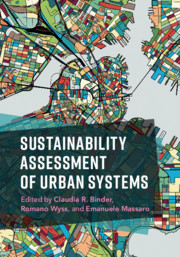Book contents
- Sustainability Assessment of Urban Systems
- Sustainability Assessment of Urban Systems
- Copyright page
- Contents
- Preface
- Acknowledgments
- Contributors
- General Introduction
- Part I Theoretical Background
- Part II Integrative Approaches for Sustainability Assessment
- Part III Perspectives on Urban Sustainability
- Part IV Focal Points of Urban Sustainability
- 15 Energy Challenges in Urban Systems
- 16 Sustainability Assessment of the Housing System: Exploring the Interplay between the Material and Social Systems
- 17 Sustainability Assessment of Urban Agriculture
- 18 Cities and Entropy: Assessing Urban Sustainability as a Problem of Coordination
- 19 Conceptualizing Urban Systems for Ecologic Sustainability Assessments: Case Study of the Stockholm Royal Seaport City District
- 20 A Study of Ride-Sharing Opportunities in the City of Santiago de Chile
- 21 Mosquito-Borne Disease and Human Mobility in Urban Environments
- Index
- References
21 - Mosquito-Borne Disease and Human Mobility in Urban Environments
from Part IV - Focal Points of Urban Sustainability
Published online by Cambridge University Press: 27 March 2020
- Sustainability Assessment of Urban Systems
- Sustainability Assessment of Urban Systems
- Copyright page
- Contents
- Preface
- Acknowledgments
- Contributors
- General Introduction
- Part I Theoretical Background
- Part II Integrative Approaches for Sustainability Assessment
- Part III Perspectives on Urban Sustainability
- Part IV Focal Points of Urban Sustainability
- 15 Energy Challenges in Urban Systems
- 16 Sustainability Assessment of the Housing System: Exploring the Interplay between the Material and Social Systems
- 17 Sustainability Assessment of Urban Agriculture
- 18 Cities and Entropy: Assessing Urban Sustainability as a Problem of Coordination
- 19 Conceptualizing Urban Systems for Ecologic Sustainability Assessments: Case Study of the Stockholm Royal Seaport City District
- 20 A Study of Ride-Sharing Opportunities in the City of Santiago de Chile
- 21 Mosquito-Borne Disease and Human Mobility in Urban Environments
- Index
- References
Summary
The epidemiology of mosquito-borne diseases is changing. This is a fact. Diseases that were mostly ‘confined’ to tropical regions are now becoming real threats for temperate countries – for instance, the chikungunya outbreak in Northern Italy in 2007, the chikungunya epidemic in the Americas and the Caribbean beginning in late 2013, the major Zika epidemic in 2015, which also led to local transmission in the US, and the recent surge of yellow fever cases in previously unaffected areas of Brazil. In this chapter, we propose a mathematical framework to emulate the dynamics of the spreading of a mosquito-borne disease in an urban environment. The main innovation of the proposed modelling framework is to improve on the current compartmental epidemiological models by considering not only vector-to-human transmission at fixed favourite cells, but also the probability of transmission along mobility pathways. This modus operandi allow us to improve the understanding of the interplay between human mobility and mosquito-borne disease in urban environments.
- Type
- Chapter
- Information
- Sustainability Assessment of Urban Systems , pp. 489 - 502Publisher: Cambridge University PressPrint publication year: 2020

